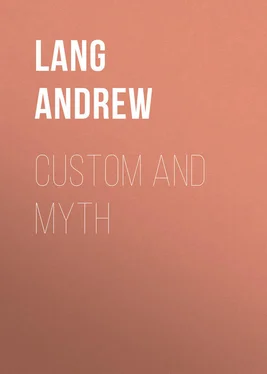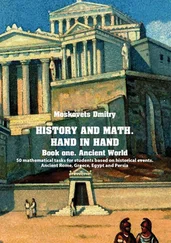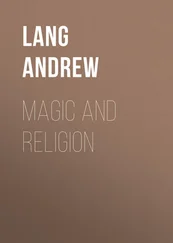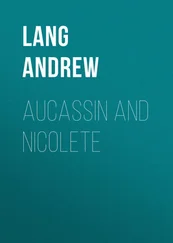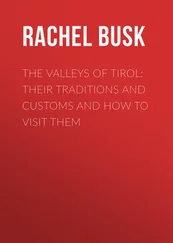Andrew Lang - Custom and Myth
Здесь есть возможность читать онлайн «Andrew Lang - Custom and Myth» — ознакомительный отрывок электронной книги совершенно бесплатно, а после прочтения отрывка купить полную версию. В некоторых случаях можно слушать аудио, скачать через торрент в формате fb2 и присутствует краткое содержание. Жанр: foreign_antique, foreign_prose, на английском языке. Описание произведения, (предисловие) а так же отзывы посетителей доступны на портале библиотеки ЛибКат.
- Название:Custom and Myth
- Автор:
- Жанр:
- Год:неизвестен
- ISBN:нет данных
- Рейтинг книги:3 / 5. Голосов: 1
-
Избранное:Добавить в избранное
- Отзывы:
-
Ваша оценка:
- 60
- 1
- 2
- 3
- 4
- 5
Custom and Myth: краткое содержание, описание и аннотация
Предлагаем к чтению аннотацию, описание, краткое содержание или предисловие (зависит от того, что написал сам автор книги «Custom and Myth»). Если вы не нашли необходимую информацию о книге — напишите в комментариях, мы постараемся отыскать её.
Custom and Myth — читать онлайн ознакомительный отрывок
Ниже представлен текст книги, разбитый по страницам. Система сохранения места последней прочитанной страницы, позволяет с удобством читать онлайн бесплатно книгу «Custom and Myth», без необходимости каждый раз заново искать на чём Вы остановились. Поставьте закладку, и сможете в любой момент перейти на страницу, на которой закончили чтение.
Интервал:
Закладка:
Let us take another piece of folklore. All North-country English folk know the Kernababy . The custom of the ‘Kernababy’ is commonly observed in England, or, at all events, in Scotland, where the writer has seen many a kernababy. The last gleanings of the last field are bound up in a rude imitation of the human shape, and dressed in some tag-rags of finery. The usage has fallen into the conservative hands of children, but of old ‘the Maiden’ was a regular image of the harvest goddess, which, with a sickle and sheaves in her arms, attended by a crowd of reapers, and accompanied with music, followed the last carts home to the farm. 9 9 ‘Ah, once again may I plant the great fan on her corn-heap, while she stands smiling by, Demeter of the threshing floor, with sheaves and poppies in her hands’ (Theocritus, vii. 155-157).
It is odd enough that the ‘Maiden’ should exactly translate Κορη, the old Sicilian name of the daughter of Demeter. ‘The Maiden’ has dwindled, then, among us to the rudimentary kernababy; but ancient Peru had her own Maiden, her Harvest Goddess. Here it is easy to trace the natural idea at the basis of the superstitious practice which links the shores of the Pacific with our own northern coast. Just as a portion of the yule-log and of the Christmas bread were kept all the year through, a kind of nest-egg of plenteous food and fire, so the kernababy, English or Peruvian, is an earnest that corn will not fail all through the year, till next harvest comes. For this reason the kernababy used to be treasured from autumn’s end to autumn’s end, though now it commonly disappears very soon after the harvest home. It is thus that Acosta describes, in Grimston’s old translation (1604), the Peruvian kernababy and the Peruvian harvest home: —
This feast is made comming from the chacra or farme unto the house, saying certaine songs, and praying that the Mays (maize) may long continue, the which they call Mama cora.
What a chance this word offers to etymologists of the old school: how promptly they would recognise, in mama mother – μητηρ, and in cora – κορη, the Mother and the Maiden, the feast of Demeter and Persephone! However, the days of that old school of antiquarianism are numbered. To return to the Peruvian harvest home: —
They take a certaine portion of the most fruitefull of the Mays that growes in their farmes, the which they put in a certaine granary which they do calle Pirua, with certaine ceremonies, watching three nightes; they put this Mays in the richest garments they have, and, being thus wrapped and dressed, they worship this Pirua, and hold it in great veneration, saying it is the Mother of the Mays of their inheritances, and that by this means the Mays augments and is preserved. In this moneth they make a particular sacrifice, and the witches demand of this Pirua, ‘if it hath strength sufficient to continue until the next yeare,’ and if it answers ‘no,’ then they carry this Mays to the farme to burne, whence they brought it, according to every man’s power, then they make another Pirua, with the same ceremonies, saying that they renue it, to the ende that the seede of the Mays may not perish.
The idea that the maize can speak need not surprise us; the Mexican held much the same belief, according to Sahagun: —
It was thought that if some grains of maize fell on the ground, he who saw them lying there was bound to lift them, wherein, if he failed, he harmed the maize, which plained itself of him to God, saying, ‘Lord, punish this man, who saw me fallen and raised me not again; punish him with famine, that he may learn not to hold me in dishonour.’
Well, in all this affair of the Scotch kernababy, and the Peruvian Mama cora , we need no explanation beyond the common simple ideas of human nature. We are not obliged to hold, either that the Peruvians and Scotch are akin by blood, nor that, at some forgotten time, they met each other, and borrowed each other’s superstitions. Again, when we find Odysseus sacrificing a black sheep to the dead, 10 10 Odyssey , xi. 32.
and when we read that the Ovahereroes in South Africa also appease with a black sheep the spirits of the departed, we do not feel it necessary to hint that the Ovahereroes are of Greek descent, or have borrowed their ritual from the Greeks. The connection between the colour black, and mourning for the dead, is natural and almost universal.
Examples like these might be adduced in any number. We might show how, in magic, negroes of Barbadoes make clay effigies of their enemies, and pierce them, just as Greeks did in Plato’s time, or the men of Accad in remotest antiquity. We might remark the Australian black putting sharp bits of quartz in the tracks of an enemy who has gone by, that the enemy may be lamed; and we might point to Boris Godunof forbidding the same practice among the Russians. We might watch Scotch, and Australians, and Jews, and French, and Aztecs spreading dust round the body of a dead man, that the footprints of his ghost, or of other ghosts, may be detected next morning. We might point to a similar device in a modern novel, where the presence of a ghost is suspected, as proof of the similar workings of the Australian mind and of the mind of Mrs. Riddell. We shall later turn to ancient Greece, and show how the serpent-dances, the habit of smearing the body with clay, and other odd rites of the mysteries, were common to Hellenic religion, and to the religion of African, Australian, and American tribes.
Now, with regard to all these strange usages, what is the method of folklore? The method is, when an apparently irrational and anomalous custom is found in any country, to look for a country where a similar practice is found, and where the practice is no longer irrational and anomalous, but in harmony with the manners and ideas of the people among whom it prevails. That Greeks should dance about in their mysteries with harmless serpents in their hands looks quite unintelligible. When a wild tribe of Red Indians does the same thing, as a trial of courage, with real rattlesnakes, we understand the Red Man’s motives, and may conjecture that similar motives once existed among the ancestors of the Greeks. Our method, then, is to compare the seemingly meaningless customs or manners of civilised races with the similar customs and manners which exist among the uncivilised and still retain their meaning. It is not necessary for comparison of this sort that the uncivilised and the civilised race should be of the same stock, nor need we prove that they were ever in contact with each other. Similar conditions of mind produce similar practices, apart from identity of race, or borrowing of ideas and manners.
Let us return to the example of the flint arrowheads. Everywhere neolithic arrow-heads are pretty much alike. The cause of the resemblance is no more than this, that men, with the same needs, the same materials, and the same rude instruments, everywhere produced the same kind of arrow-head. No hypothesis of interchange of ideas nor of community of race is needed to explain the resemblance of form in the missiles. Very early pottery in any region is, for the same causes, like very early pottery in any other region. The same sort of similarity was explained by the same resemblances in human nature, when we touched on the identity of magical practices and of superstitious beliefs. This method is fairly well established and orthodox when we deal with usages and superstitious beliefs; but may we apply the same method when we deal with myths?
Here a difficulty occurs. Mythologists, as a rule, are averse to the method of folklore. They think it scientific to compare only the myths of races which speak languages of the same family, and of races which have, in historic times, been actually in proved contact with each other. Thus, most mythologists hold it correct to compare Greek, Slavonic, Celtic, and Indian stories, because Greeks, Slavs, Celts, and Hindoos all speak languages of the same family. Again, they hold it correct to compare Chaldæan and Greek myths, because the Greeks and the Chaldæans were brought into contact through the Phœnicians, and by other intermediaries, such as the Hittites. But the same mythologists will vow that it is unscientific to compare a Maori or a Hottentot or an Eskimo myth with an Aryan story, because Maoris and Eskimo and Hottentots do not speak languages akin to that of Greece, nor can we show that the ancestors of Greeks, Maoris, Hottentots, and Eskimo were ever in contact with each other in historical times.
Читать дальшеИнтервал:
Закладка:
Похожие книги на «Custom and Myth»
Представляем Вашему вниманию похожие книги на «Custom and Myth» списком для выбора. Мы отобрали схожую по названию и смыслу литературу в надежде предоставить читателям больше вариантов отыскать новые, интересные, ещё непрочитанные произведения.
Обсуждение, отзывы о книге «Custom and Myth» и просто собственные мнения читателей. Оставьте ваши комментарии, напишите, что Вы думаете о произведении, его смысле или главных героях. Укажите что конкретно понравилось, а что нет, и почему Вы так считаете.
